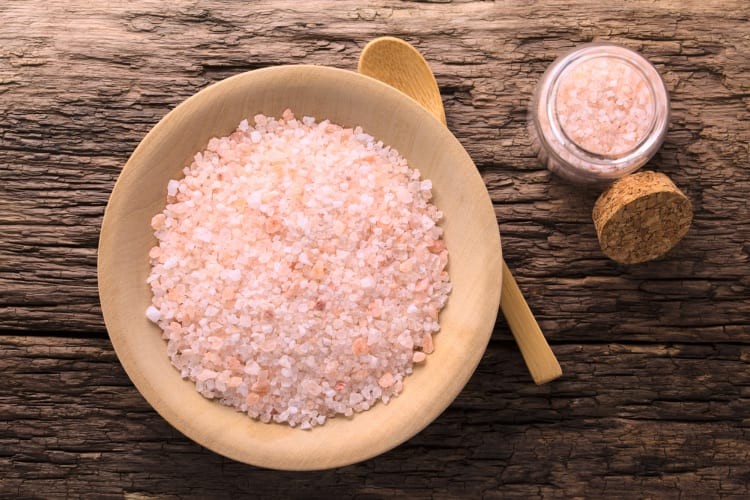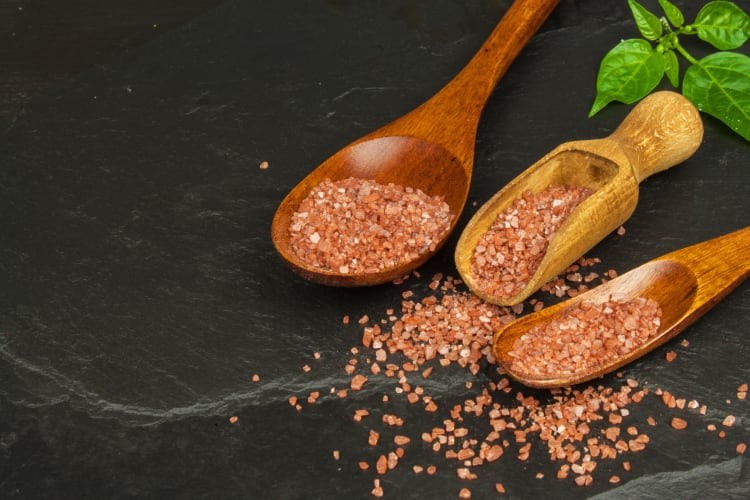What Is Comparable To Kosher Salt? Kosher salt is a staple in many kitchens, but COMPARE.EDU.VN provides a comprehensive guide to finding the best alternatives and understanding its unique properties, offering solutions when you’re in a pinch. Discover ideal kosher salt replacements, exploring their flavor profiles and applications for baking, cooking, and more, ensuring a perfect dish every time with these flavor enhancers and seasoning options.
1. Understanding Kosher Salt
1.1. Defining Kosher Salt
Kosher salt is a type of salt known for its purity and coarse texture. Unlike table salt, it doesn’t contain iodine or anti-caking agents, providing a cleaner, less bitter flavor. Its name comes from its use in the koshering process, where it’s used to draw blood from meat. This process adheres to Jewish dietary laws, but the salt itself is not inherently “kosher.” It’s simply salt with a specific texture and composition that makes it effective for this purpose.
1.2. The Difference Between Kosher Salt and Table Salt
The key differences between kosher salt and table salt lie in their texture, additives, and taste. Table salt is finely ground and usually contains iodine and anti-caking agents, giving it a more metallic, sometimes bitter taste. Kosher salt, with its larger, irregular crystals, dissolves more slowly and provides a more subtle, pure salt flavor. This makes it easier to control the seasoning in your cooking.
Here’s a simple comparison:
| Feature | Kosher Salt | Table Salt |
|---|---|---|
| Texture | Coarse, irregular crystals | Fine, uniform grains |
| Additives | None (usually) | Iodine, anti-caking agents |
| Taste | Clean, pure salt flavor | More intense, sometimes bitter |
| Dissolving Rate | Slower | Faster |
| Best Uses | Seasoning, brining, curing | Baking, general seasoning |




1.3. Why Kosher Salt Is Preferred by Chefs
Many chefs prefer kosher salt because of its clean taste and the control it offers in seasoning. The larger crystals are easy to pinch and distribute evenly, allowing for precise flavor adjustments. Also, the absence of iodine prevents any unwanted bitter notes in the final dish. Its versatility extends from everyday cooking to more specialized techniques like brining and curing, making it a staple in professional kitchens.
2. The Role of Kosher Salt in Cooking
2.1. Enhancing Flavor in Dishes
Kosher salt enhances the flavor of dishes by drawing out natural flavors in ingredients. Its larger crystals create a more impactful burst of saltiness when they dissolve, compared to the more muted effect of table salt. This is particularly noticeable in dishes where salt is a key component, such as roasted vegetables, grilled meats, and homemade sauces.
2.2. Kosher Salt in Baking Applications
In baking, kosher salt plays a dual role. It not only balances sweetness but also strengthens gluten development in dough. The larger crystals dissolve slowly, providing a more consistent saltiness throughout the baked goods. Some bakers also use kosher salt as a decorative topping for breads and pastries, adding a visual appeal and a satisfying crunch.
2.3. Brining and Curing with Kosher Salt
Kosher salt is ideal for brining and curing due to its purity and lack of additives. In brining, it helps to tenderize and moisturize meats, while in curing, it draws out moisture and inhibits bacterial growth. The absence of iodine is crucial in these processes, as iodine can interfere with the curing process and alter the flavor of the final product.
3. What To Consider When Choosing a Kosher Salt Substitute
3.1. Taste Profile
When selecting a kosher salt substitute, consider the taste profile of the alternative. Some salts, like sea salt, have a similar clean flavor, while others, like Himalayan pink salt, have a more mineral-rich taste. Think about how the flavor of the substitute will complement the dish you’re preparing.
3.2. Texture and Crystal Size
Texture and crystal size are important factors to consider. Kosher salt’s coarse texture allows for even distribution and a controlled release of flavor. Look for substitutes with similar textures, such as coarse sea salt or flake salt, to achieve a comparable effect.
3.3. Additives and Purity
Check for additives like iodine and anti-caking agents. For most culinary applications, you’ll want a pure salt without these additives to avoid any off-flavors or unwanted effects on the dish. Pure salts provide the cleanest and most consistent flavor.
4. Top Kosher Salt Substitutes and Alternatives
4.1. Sea Salt
4.1.1. Coarse Sea Salt
Coarse sea salt is an excellent 1:1 substitute for kosher salt. Its flaky texture and similar grain size make it ideal for seasoning and garnishing foods. However, be cautious of over-seasoning, as sea salt can dissolve slightly faster than kosher salt.
4.1.2. Fine Sea Salt
Fine sea salt is more similar to table salt in texture, so while it can be used as a substitute, it’s best to use it in smaller quantities. Use about ¾ teaspoon of fine sea salt for every 1 teaspoon of kosher salt. It’s great for baking where even distribution is important, but less ideal for topping or brining.
4.2. Himalayan Pink Salt
Himalayan pink salt is known for its beautiful color and mineral-rich composition. It offers a milder, more complex flavor compared to kosher salt, making it a great option for seasoning and finishing dishes. Use it in a 1:1 ratio, but keep in mind its unique taste will impart a slightly different flavor.
4.3. Fleur de Sel
Fleur de sel, or “flower of salt,” is a delicate and briny salt harvested from the surface of seawater. It’s best used as a finishing salt to add a burst of flavor and texture to dishes. Due to its intense flavor, use it sparingly – start with ½ teaspoon of fleur de sel for every 1 teaspoon of kosher salt.
4.4. Maldon Sea Salt
Maldon sea salt is a type of flake salt known for its clean, light flavor and soft, flaky texture. Its large, pyramid-shaped crystals add a pleasant crunch to dishes. Use a 1:1 ratio as a substitute, but adjust to taste, as its flavor is more subtle than kosher salt.
4.5. Pickling Salt
Pickling salt, also known as canning salt, is a pure, additive-free salt that’s similar in taste to kosher salt. It’s a good option for canning, pickling, and general cooking. Use 1 ¼ to 1 ½ teaspoons of pickling salt for every 1 teaspoon of kosher salt.
4.6. Hawaiian Red Salt
Hawaiian red salt, or alaea salt, gets its reddish color from the iron oxide in the volcanic clay it’s mixed with. It has a unique earthy flavor that can add depth to dishes. Use it in a 1:1 ratio, and consider using it to season dishes that would benefit from its distinct flavor.
5. Conversion Ratios: Substituting Kosher Salt with Other Salts
5.1. Table Salt vs. Kosher Salt Conversion
Table salt is denser than kosher salt, so you’ll need less of it to achieve the same level of saltiness. Use ½ teaspoon of table salt for every 1 teaspoon of kosher salt.
5.2. Sea Salt vs. Kosher Salt Conversion
Coarse sea salt can be used in a 1:1 ratio with kosher salt. For fine sea salt, use ¾ teaspoon for every 1 teaspoon of kosher salt.
5.3. Flake Salt vs. Kosher Salt Conversion
Flake salt, such as Maldon, has a more delicate flavor and texture, so use a 1:1 ratio. You may want to add a bit more to taste.
Here’s a quick reference table:
| Salt Type | Conversion Ratio (per 1 tsp Kosher Salt) | Notes |
|---|---|---|
| Table Salt | ½ tsp | Denser, use less to avoid over-salting |
| Coarse Sea Salt | 1 tsp | Similar texture and flavor, good for general use |
| Fine Sea Salt | ¾ tsp | Finer texture, use slightly less |
| Flake Salt (Maldon) | 1 tsp (adjust to taste) | Delicate flavor, may need to add more |
| Pickling Salt | 1 ¼ – 1 ½ tsp | Pure salt without additives, good for canning and pickling |
| Himalayan Pink Salt | 1 tsp | Mineral-rich flavor, use for seasoning and finishing |
| Fleur de Sel | ½ tsp | Intense, briny flavor, use sparingly as a finishing salt |
6. Practical Applications of Kosher Salt Substitutes
6.1. Cooking
When cooking, consider the flavor profile of the salt substitute. Sea salt works well in most dishes, while Himalayan pink salt can add a unique mineral flavor. Use the conversion ratios to adjust the amount and taste as you go.
6.2. Baking
In baking, use fine sea salt for even distribution. If using a coarser salt, dissolve it in liquid ingredients first. Adjust the amount based on the conversion ratios to avoid over-salting.
6.3. Finishing
For finishing, flake salt and fleur de sel are excellent choices. Their delicate textures and intense flavors add a gourmet touch to any dish. Sprinkle them on just before serving to preserve their unique qualities.
7. Potential Drawbacks of Using Substitutes
7.1. Flavor Differences
Each salt substitute has a unique flavor profile. While some, like sea salt, are very similar to kosher salt, others, like Himalayan pink salt, have a more distinct taste. This can affect the overall flavor of your dish, so it’s important to choose a substitute that complements the other ingredients.
7.2. Texture Variations
Texture variations can also impact the final result. Coarse salts provide a burst of flavor, while fine salts dissolve more evenly. Choose a texture that suits the application, and adjust the amount accordingly.
7.3. Availability and Cost
Some salt substitutes, like fleur de sel, can be more expensive and difficult to find than kosher salt. Consider the availability and cost when choosing a substitute, especially if you’re cooking on a budget or need a readily available option.
8. Health Considerations of Salt Intake
8.1. Recommended Daily Intake of Sodium
The American Heart Association recommends no more than 2,300 milligrams of sodium per day for most adults, with an ideal limit of no more than 1,500 mg per day. It’s important to be mindful of your salt intake, regardless of the type of salt you use.
8.2. Impact of Different Salts on Sodium Levels
While different salts have slightly different sodium levels by weight, the impact on your overall sodium intake is minimal. The key is to use salt in moderation and be aware of the sodium content of other ingredients in your diet.
8.3. Healthier Alternatives and Low-Sodium Options
If you’re looking to reduce your sodium intake, consider using herbs, spices, and citrus juices to add flavor to your dishes. Low-sodium salt substitutes are also available, but be mindful of their taste, as they can have a slightly metallic flavor.
9. Kosher Salt vs. Other Salts: A Comparative Analysis
9.1. Sodium Content Comparison
Here’s a comparison of the sodium content in different types of salt:
| Salt Type | Sodium Content (per 1/4 tsp) |
|---|---|
| Table Salt | 590 mg |
| Kosher Salt | 480 mg |
| Sea Salt | 480 mg |
| Himalayan Pink Salt | 420 mg |
9.2. Mineral Composition
Different salts have different mineral compositions. Himalayan pink salt is known for its mineral content, including magnesium, potassium, and calcium. Sea salt also contains trace minerals, while table salt and kosher salt are primarily sodium chloride.
9.3. Culinary Uses
Each salt has its own culinary uses. Table salt is good for general seasoning, kosher salt is ideal for brining and curing, sea salt is versatile for cooking and finishing, and flake salt is best for adding a gourmet touch to dishes.
10. Frequently Asked Questions (FAQs) About Kosher Salt Substitutes
10.1. Can I use table salt as a kosher salt substitute?
Yes, you can, but use only half the amount. Table salt is denser and more intense in flavor than kosher salt.
10.2. Is sea salt a good substitute for kosher salt?
Coarse sea salt is an excellent substitute due to its similar texture and flavor.
10.3. What is the best kosher salt substitute for baking?
Fine sea salt is a good option for baking because it dissolves evenly and distributes the saltiness throughout the baked goods.
10.4. Can I use Himalayan pink salt in place of kosher salt?
Yes, you can, but be aware that Himalayan pink salt has a more complex, mineral-rich flavor that may affect the taste of your dish.
10.5. What is fleur de sel, and how do I use it?
Fleur de sel is a delicate, briny salt harvested from the surface of seawater. It’s best used as a finishing salt to add a burst of flavor and texture to dishes.
10.6. How much pickling salt should I use as a kosher salt substitute?
Use 1 ¼ to 1 ½ teaspoons of pickling salt for every 1 teaspoon of kosher salt.
10.7. What is the difference between kosher salt and pickling salt?
Kosher salt and pickling salt are both pure salts without additives, making them interchangeable in many recipes.
10.8. Can I use any salt for koshering meat?
Kosher salt is preferred for koshering meat because its coarse texture is effective at drawing out blood. However, coarse sea salt can also be used.
10.9. Is there a low-sodium alternative to kosher salt?
Yes, there are low-sodium salt substitutes available, but be mindful of their taste, as they can have a slightly metallic flavor.
10.10. How does the crystal size of salt affect its flavor?
Larger salt crystals provide a more impactful burst of saltiness when they dissolve, while smaller crystals dissolve more evenly and provide a more consistent saltiness.
11. Expert Tips for Using Salt in Cooking
11.1. Seasoning in Layers
Seasoning in layers means adding salt at different stages of the cooking process. This allows the flavors to develop and ensures that the dish is evenly seasoned.
11.2. Using Salt to Balance Flavors
Salt can be used to balance other flavors in a dish, such as sweetness, acidity, and bitterness. A pinch of salt can enhance the sweetness of a dessert or cut through the acidity of a tomato sauce.
11.3. Salt and Texture
Salt can also affect the texture of food. It can tenderize meats, crisp up vegetables, and strengthen gluten in dough.
12. Conclusion: Finding the Right Kosher Salt Substitute for Your Needs
Choosing the right kosher salt substitute depends on your specific needs and preferences. Consider the flavor profile, texture, availability, and cost of each option. Whether you’re cooking, baking, or finishing a dish, there’s a salt substitute that will work for you. Remember, COMPARE.EDU.VN is here to help you make informed decisions and find the best options for your culinary adventures.
Navigating the world of salt substitutes can be overwhelming, but COMPARE.EDU.VN makes it easy to find the perfect alternative to kosher salt. Don’t let the lack of kosher salt stop you from creating delicious meals. Visit compare.edu.vn today at 333 Comparison Plaza, Choice City, CA 90210, United States, or contact us via Whatsapp at +1 (626) 555-9090 to explore more comparisons and make informed decisions. We’re here to assist you in finding the best solutions for all your cooking and baking needs.